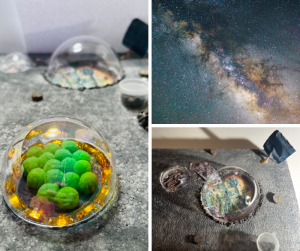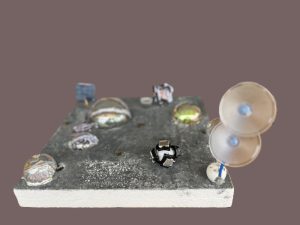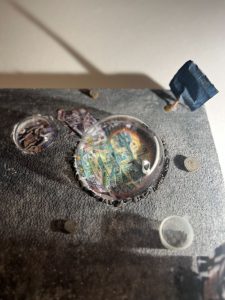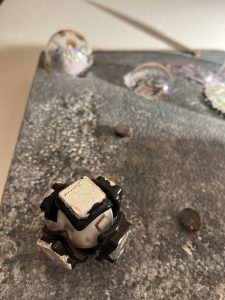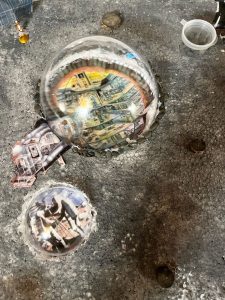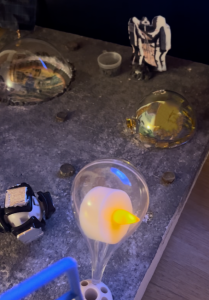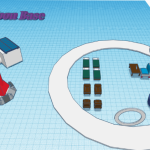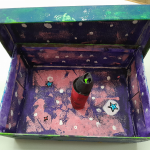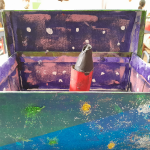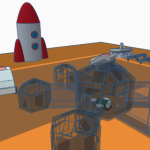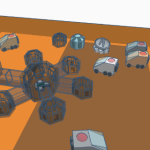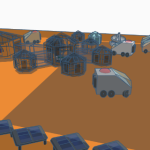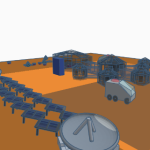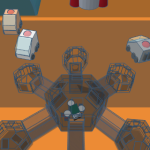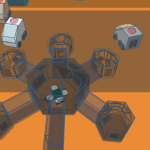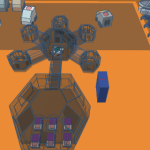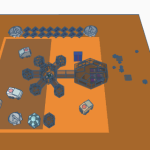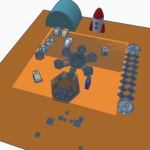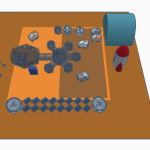Moon Camp – Semisfere lunari by Giacomo A., Tommaso C., Matilde D., Lodovica D. e David S.
Scuola Santa Giovanna d’Arco Vittorio Veneto-TV Italy 13 years old 5 / 2 Italian Moon
Project description
Moon Camp – Semisfere lunari
Plastico realizzato con polistirolo, plastica e altro materiale di riciclo.
Abbiamo creato una base lunare partendo dalle sfide che l’ambiente lunare comporta. In modo particolare, ci siamo soffermati sulle temperature estreme, la mancanza di acqua, le radiazioni, il pericolo di collisione con asteroidi, la durata prolungata del giorno e della notte, oltre alla mancanza di vita.
La base sarà costruita in prossimità di cavità lunari nelle quali è presente una temperatura più stabile. Si tratta di vere e proprie grotte che offrono rifugio per gli esseri umani in quanto proteggono dai raggi cosmici, dalla radiazione del Sole e da micrometeoriti. Grazie agli studi condotti da Tyler Horvath, ricercatore dell’Università della California a Los Angeles, almeno 16 dei 200 “pozzi lunari” sulla Luna probabilmente sono tubi di lava collassati. Se la parte superiore del tubo di lava crolla (una volta solidificato), si apre una fossa e si può creare una vera e propria grotta sottostante.
Tali cavità lunari saranno accessibili attraverso un ingresso protetto da resine trasparenti molto resistenti a forma semisferica. Nell’ingresso verrà impiegata anche una nuova lega di alluminio scoperta da un team dell’Università di Leoben in Austria. Essa riesce a schermare le radiazioni cento volte meglio delle leghe metalliche usate finora.
I residenti lunari si nutriranno grazie all’agricoltura idroponica e aeroponica. L’alterarsi del giorno e della notte lunare è di 29.5 giorni terrestri, di cui 14.25 di luce e 14.25 di buio. Per questo motivo, fornire luce artificiale sarà fondamentale per la crescita delle piante. Useremo particolari luci LED per promuovere la loro crescita, con lunghezze d’onda diverse che favoriscono fasi di crescita specifiche. Manipolando gli spettri luminosi, ottimizzeremo i tassi di crescita e il contenuto nutrizionale delle colture.
Sulla base lunare verrà anche estratta acqua dal ghiaccio attraverso una particolare trivella montata su un rover che perforerà la superficie lunare prelevandone dei campioni. Questi campioni verranno analizzati per identificare la presenza di acqua, estrarla e renderla potabile.
L’ossigeno verrà ricavato dall’elettrolisi attraverso un dispositivo in grado di sciogliere la regolite lunare e trasformarla in ossigeno.
Infine, per ovviare all’atrofia muscolare dovuta alla bassa gravità lunare rispetto a quella terrestre, seguiremo un programma di esercizio dettagliato che comprende esercizi cardiovascolari, esercizi di forza ed esercizi di resistenza con attrezzature specializzate per mantenerci in forma.
English translation
Moon Camp – Lunar hemispheres
Plastic made with polystyrene, plastic and other recycled material.
We created a lunar base starting from the challenges that the lunar environment entails. In particular, we focused on extreme temperatures, the lack of water, radiation, the danger of collision with asteroids, the prolonged duration of day and night, as well as the lack of life.
The base will be built near lunar cavities where there is a more stable temperature. These are real caves that offer refuge for human beings as they protect from cosmic rays, radiation from the Sun and micrometeorites. Thanks to studies conducted by Tyler Horvath, a researcher at the University of California at Los Angeles, at least 16 of the 200 “moon pits” on the Moon are probably collapsed lava tubes. If the top part of the lava tube collapses (once solidified), a pit opens up and a real cave can be created underneath.
These lunar cavities will be accessible through an entrance protected by very resistant transparent resins with a hemispherical shape. A new aluminum alloy discovered by a team from the University of Leoben in Austria will also be used in the entrance. It is able to shield radiation a hundred times better than the metal alloys used so far.
Lunar residents will feed themselves thanks to hydroponic and aeroponic agriculture. The alternation of lunar day and night is 29.5 Earth days, of which 14.25 are light and 14.25 are dark. For this reason, providing artificial light will be crucial for plant growth. We will use particular LED lights to promote their growth, with different wavelengths that favor specific growth phases. By manipulating light spectra, we will optimize the growth rates and nutritional content of crops.
On the lunar base, water will also be extracted from the ice through a special drill mounted on a rover which will drill into the lunar surface and take samples. These samples will be analyzed to identify the presence of water, extract it and make it drinkable.
Oxygen will be obtained from electrolysis through a device capable of melting lunar regolith and transforming it into oxygen.
Finally, to overcome muscle atrophy due to the low lunar gravity compared to Earth’s, we will follow a detailed exercise program that includes cardiovascular exercises, strength exercises and resistance exercises with specialized equipment to keep us fit .
#Arts & Crafts
Other Projects
The Friendship galaxy MOON Base




